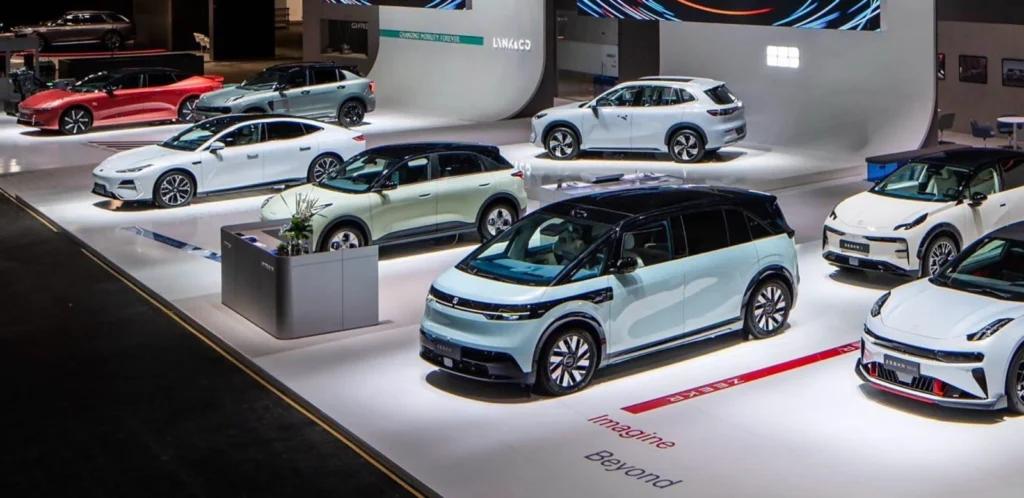The electric vehicle (EV) industry in China, once hailed for its dynamic growth and ability to disrupt global automotive giants like BMW and Mercedes-Benz, now faces a shift in momentum. After making initial strides into the luxury car market, Chinese manufacturers, once seen as innovators and disruptors, are confronting a more challenging landscape in 2024. Analysts predict a significant slowdown in the release of new premium models, attributing the shift to both weak demand and dwindling financial resources. As China’s electric vehicle market matures, its premium segment, once the hotbed of intense competition, is now showing signs of slowing growth, reflecting the broader challenges faced by the industry.
This analysis delves into the factors contributing to this shift, exploring market trends, company strategies, and the complex dynamics of consumer demand in China’s luxury EV space.
The Rise and Fall of China’s Luxury EV Surge
China’s initial foray into the luxury EV market was marked by momentous success. Domestic manufacturers like BYD, Xpeng, Nio, and Li Auto began to chip away at the dominance of traditional luxury automakers. Electric vehicles, once considered a niche market, started to gain serious traction among premium buyers, especially as these Chinese automakers introduced sophisticated designs, cutting-edge technology, and competitive pricing.

However, as we approach 2025, the momentum appears to have plateaued. In an industry accustomed to rapid growth, China’s premium EV segment now faces an uncertain future. Analysts predict that sales of high-end electric models will slow down, at least in the short term, as consumer preferences shift and cost pressures mount. The optimistic forecast of Chinese EV makers carving out an ever-larger slice of the luxury market has been tempered by reality.
The Latest Example: Denza’s Struggles
A clear illustration of this downturn comes from Denza New Energy Automotive, a venture between BYD and Mercedes-Benz. On a Thursday in Shenzhen, Denza unveiled the 2025 version of its flagship D9—a luxury multipurpose vehicle (MPV) that incorporates BYD’s advanced BAS 3.0+ driving assistance system. The vehicle comes in several variants, including both plug-in hybrids and pure electric versions, with prices ranging from 339,800 yuan ($46,555) to 469,800 yuan. Despite the technological advancements and diverse offering, Denza has encountered significant challenges in the market.
According to data from Autohome, one of China’s leading automotive websites, monthly sales of the D9 showed a decline between July and September when compared to the previous year. Denza’s third-quarter earnings report indicated a 14 percent drop in sales compared to the previous quarter, further corroborating the trend of stagnation.
This downturn is not an isolated case but rather part of a broader industry trend. Phate Zhang, the founder of CnEVPost, an electric car data provider based in Shanghai, notes that carmakers are likely to slow down their launch of new premium models in 2025. Zhang suggests that the focus will shift towards enhancing existing models rather than pushing for the rapid introduction of new ones.
A Complex Market for Premium EVs
The market for premium electric vehicles—those priced above 200,000 yuan—has become a fierce battleground. Leading players like Li Auto, Xpeng, and Nio are competing aggressively for market share, all while struggling to secure their place in a market that is proving difficult to expand. Chinese automakers are keen on bolstering their brand image and increasing their customer base, yet the market’s growth potential appears to be limited.
Zeekr, the luxury EV arm of Geely, and BYD, the largest manufacturer of plug-in hybrids and battery EVs globally, are among the other notable players in the premium space. Despite their advances, however, these companies face a fundamental challenge: the premium vehicle market is simply too small to accommodate the large number of manufacturers vying for consumer attention.
The Huawei Technologies collaboration with Anhui Jianghuai Automobile Group, a state-owned enterprise, underscores this point. The two companies launched a new ultra-luxury car brand, Maextro, hoping to take on heavyweights like Rolls-Royce. Their first offering, the Maextro S800 sedan, is priced between 1 million and 1.5 million yuan, a bold move to position themselves in a highly exclusive market. Yet, the limited growth potential of this market remains evident, with sales of premium new energy vehicles (NEVs)—including both plug-in hybrids and pure battery EVs—accounting for only 10 percent of China’s total EV sales in 2024, according to the China Passenger Car Association (CPCA).
Pricing Pressures and Market Realities
The luxury EV sector is also feeling the squeeze from price pressures. The CPCA reports that the growth in sales of NEVs priced above 300,000 yuan has been slower compared to vehicles sold below that threshold. This price sensitivity is exacerbated by the fact that many Chinese consumers are still more inclined toward affordable EVs—a factor that premium models struggle to overcome.
The broader electric vehicle market in China, however, is expected to continue growing. A recent investment report from SPDB International predicts a 28 percent year-on-year increase in the sales of new energy vehicles (NEVs) in 2025, with 15.78 million units expected to be sold next year. Despite this optimistic forecast, the growth rate for premium models is expected to slow as manufacturers find themselves unable to sustain the rapid expansion they initially hoped for.
The Strain of the Price War and Competition
The ongoing price war among Chinese automakers has also added complexity to the situation. With new entrants launching premium models and established players continually adjusting their strategies, the market has become saturated, and margins have been squeezed. Zhang Xiang, an expert at the Jiangxi New Energy Technology Institute, explains that many companies are struggling to enter the premium market, with weak sales and massive investment losses pushing some to rethink their approach.
One notable example of this struggle comes from Geely, which announced in November 2024 that it would integrate its Lynk & Co brand into Zeekr due to the former’s unprofitability. Another company facing difficulties is Human Horizons, a Shanghai-based maker of premium EVs. The company announced earlier this year that it would halt the production of its luxury HiPhi brand, signaling the end of an ambitious attempt at premiumisation in the EV space.
A Critical Juncture for the Chinese EV Makers
As the industry evolves, Phate Zhang of CnEVPost believes we are witnessing the beginning of the end for the initial wave of premiumisation within China’s electric vehicle sector. Fewer new premium models are being launched, and companies are becoming more cautious in their strategies. The premium EV market, once seen as the key to the future growth of Chinese automakers, now appears to be entering a period of recalibration. The challenge going forward will be to strike the right balance between innovation, affordability, and profitability—a delicate act that many manufacturers will struggle to achieve in the coming years.
Conclusion: Navigating a Changing Landscape
The future of luxury EVs in China is being shaped by complex challenges—demand saturation, pricing pressures, and increasing competition. As the industry matures, manufacturers will need to shift their focus from rapid expansion to sustainable growth. The question remains: can Chinese automakers continue to compete in the premium space, or will they need to redefine their strategies to focus on more profitable, mass-market segments?
The luxury EV sector in China, still in its nascent stages, holds promise but is now at a crossroads. Whether it can overcome its growing pains and continue to challenge established global brands is a narrative that will unfold over the coming years, requiring careful strategy, innovation, and a deep understanding of consumer needs.
In the end, the road ahead for Chinese luxury EV makers may not be as smooth as initially anticipated, but it will undoubtedly be filled with lessons that will shape the future of the global EV market.



